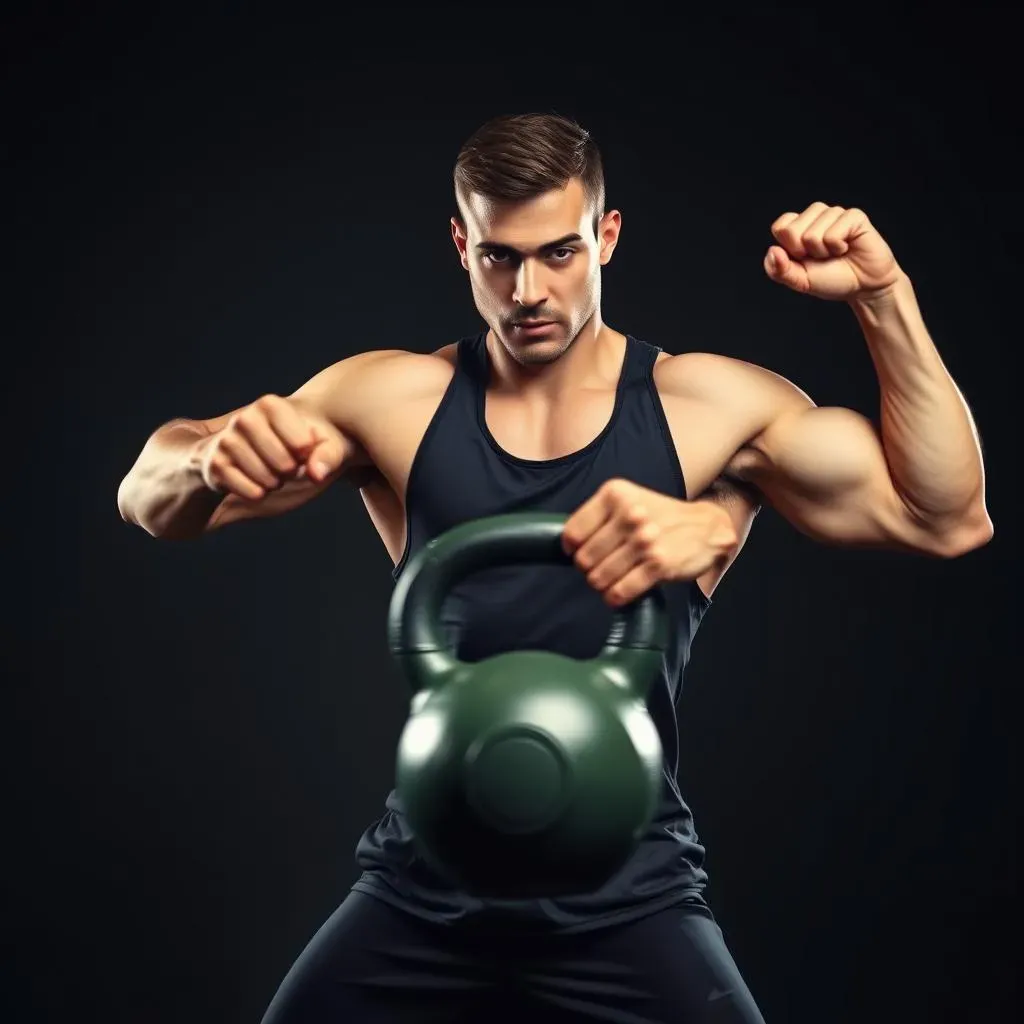Table of Contents
Ready to ditch the dumbbells and forge serious upper body and core strength? Then grab a kettlebell! This isn't your average gym routine. An upper body and core kettlebell workout is a fast track to building functional muscle, boosting stability, and torching calories, all at the same time. We're talking real-world strength, the kind that makes everyday tasks feel effortless and leaves you feeling like a total badass. In this article, we'll explore why kettlebells are so effective, dive into 10 essential exercises, and break down the proper form and technique for each. Plus, we'll give you the tools to build your own customized workout plan, so you can start seeing results fast. Forget endless crunches and bicep curls; it's time to unlock the power of the kettlebell and sculpt the strong, resilient body you've always wanted. Let's swing into action!
Why Kettlebells are Your Secret Weapon for Upper Body and Core Strength

Why Kettlebells are Your Secret Weapon for Upper Body and Core Strength
Unlocking Full-Body Potential with Kettlebells
So, you're curious about kettlebells, huh? Let me tell you, they're not just trendy gym toys. They're a powerhouse for building serious strength, especially when it comes to your upper body and core. Unlike dumbbells, kettlebells have an offset center of gravity, which forces your muscles to work harder to stabilize and control the weight. This constant engagement translates to a more intense workout and faster results. Think about it: every swing, press, and lift becomes a full-body exercise, firing up your core and challenging your stability in ways you never thought possible.
Ever notice how most everyday movements aren't perfectly balanced? You're carrying groceries in one arm, reaching for something overhead, or twisting to grab something from the backseat of your car. Kettlebells mimic these real-life scenarios, making your workouts more functional and preparing your body for the demands of daily life. Plus, the dynamic nature of kettlebell exercises improves your coordination, balance, and overall athleticism. Forget those boring isolation exercises; kettlebells offer a full-body party that'll leave you feeling stronger, more agile, and ready to tackle anything.
Beyond the Biceps: Core Engagement and Functional Fitness
It's not just about bigger biceps (though, let's be honest, that's a nice bonus). The real magic of kettlebells lies in their ability to engage your core like never before. That offset center of gravity I mentioned? It forces your core muscles to constantly work to stabilize your spine and prevent you from toppling over. This translates to a stronger, more stable core that improves your posture, protects your back, and enhances your athletic performance. You'll feel the difference in everything you do, from lifting heavy objects to simply standing up straight.
And the best part? You don't need a ton of fancy equipment or a massive gym to reap the benefits. A single kettlebell can provide a full-body workout that targets every major muscle group. This makes kettlebells a fantastic option for home workouts, travel workouts, or anyone who's short on time or space. Plus, learning kettlebell exercises is an investment in your long-term health and fitness. Once you master the basics, you'll have a versatile tool that you can use to challenge yourself and stay in shape for years to come.
Benefit | Description |
|---|---|
Full-Body Engagement | Kettlebells work multiple muscle groups simultaneously, leading to a more efficient and effective workout. |
Core Strengthening | The offset center of gravity challenges your core stability, improving posture and reducing back pain. |
Functional Fitness | Kettlebell exercises mimic real-life movements, preparing your body for the demands of daily activities. |
Versatility | A single kettlebell can be used for a wide variety of exercises, making it a great option for home workouts. |
10 Killer Kettlebell Exercises for a RockSolid Upper Body and Core

10 Killer Kettlebell Exercises for a RockSolid Upper Body and Core
Unleash Your Inner Beast: Top Kettlebell Moves
Alright, let's get down to business! We're talking about the 10 killer kettlebell exercises for a rock-solid upper body and core that will transform your physique and your functional strength. Forget endless hours of boring cardio; these moves are designed to build muscle, burn fat, and challenge your stability, all in one go. We're not just going through the motions here. Each of these exercises is carefully selected to target specific muscle groups, improve your coordination, and enhance your overall athleticism. So, ditch the excuses, grab a kettlebell, and let's get ready to sweat!
Each exercise is selected to target specific muscle groups, improve your coordination, and enhance your overall athleticism. Remember, proper form is key to avoiding injuries and maximizing results. Start with lighter weights and focus on mastering the technique before increasing the load. Listen to your body, and don't be afraid to modify the exercises to fit your fitness level. It's all about progress, not perfection. We'll be diving deep into form and technique in the next section, but for now, let's get a sneak peek at the moves that will redefine your upper body and core strength.
Perfecting Your Form: Essential Techniques for Upper Body and Core Kettlebell Exercises

Perfecting Your Form: Essential Techniques for Upper Body and Core Kettlebell Exercises
The Foundation of Kettlebell Mastery: Why Form Matters
Alright, so you're ready to swing some iron, but hold up a sec! Before you start throwing kettlebells around like a Viking warrior, let's talk about form. Perfecting your form isn't just about looking good in the gym mirror; it's about protecting your body, maximizing your results, and building a solid foundation for long-term progress. Think of it like building a house: if the foundation is weak, the whole structure will eventually crumble. The same goes for kettlebell training. If your form is sloppy, you're setting yourself up for injuries and limiting your potential.
We're talking about everything from your grip to your stance to your breathing. Every detail matters. Proper form ensures that you're engaging the right muscles, distributing the weight evenly, and minimizing stress on your joints. It's like a symphony of movement, where every muscle works in harmony to create a powerful and efficient action. When your form is dialed in, you'll not only feel stronger and more stable, but you'll also be able to lift heavier weights and perform more reps with ease.
Breathing, Bracing, and Balance: The Trifecta of Kettlebell Form
let's break down the key elements of kettlebell form. First up: breathing. Sounds simple, right? But proper breathing is crucial for maintaining stability and generating power. The general rule of thumb is to exhale during the most challenging part of the exercise and inhale during the easier part. For example, during a kettlebell swing, you'd exhale as you drive your hips forward and inhale as you swing the kettlebell back down. This helps to engage your core and stabilize your spine.
Next, bracing. Think of bracing as creating a "shield" around your torso. Before you lift the kettlebell, take a deep breath and tighten your core muscles as if you're about to be punched in the stomach. This will protect your spine and prevent you from rounding your back. Finally, balance. Kettlebell exercises often involve dynamic movements that challenge your balance. Keep your weight centered, engage your core, and focus on maintaining a stable base of support. If you're wobbling all over the place, it's a sign that you need to lighten the load or work on your stability.
Element | Description | Benefit |
|---|---|---|
Breathing | Exhale during exertion, inhale during recovery. | Stabilizes spine, generates power. |
Bracing | Tighten core muscles before lifting. | Protects spine, prevents injury. |
Balance | Maintain a stable base of support. | Improves coordination, prevents falls. |
Common Mistakes and How to Fix Them
Even with the best intentions, it's easy to fall into common form mistakes when you're first starting out with kettlebells. One of the biggest culprits is rounding your back during exercises like the kettlebell swing or deadlift. This puts excessive stress on your spine and can lead to serious injuries. To fix this, focus on maintaining a neutral spine throughout the movement. Engage your core, keep your chest up, and avoid letting your back round.
Another common mistake is using your arms too much during exercises like the kettlebell swing. The swing is primarily a hip-hinge movement, driven by the glutes and hamstrings. Your arms should simply guide the kettlebell, not lift it. To correct this, focus on driving your hips forward and squeezing your glutes at the top of the swing. Finally, many people tend to rush through their reps, sacrificing form for speed. Slow down, focus on control, and prioritize quality over quantity. It's better to do fewer reps with perfect form than to crank out a bunch of sloppy reps that put you at risk of injury.
Building Your Upper Body and Core Kettlebell Workout Plan: Sets, Reps, and Progression

Building Your Upper Body and Core Kettlebell Workout Plan: Sets, Reps, and Progression
Crafting Your Kettlebell Blueprint: A Personalized Approach
So, you're armed with the exercises and the proper form, but how do you actually piece it all together into a workout that's effective and, dare I say, enjoyable? That's where building your upper body and core kettlebell workout plan comes in. It's not about blindly following a cookie-cutter routine; it's about creating a plan that's tailored to your individual goals, fitness level, and preferences. Think of it as crafting your own personal kettlebell blueprint, a roadmap to a stronger, more resilient you.
First things first, what are you trying to achieve? Are you looking to build muscle, burn fat, improve your endurance, or simply become more functionally fit? Your goals will dictate the types of exercises you choose, the number of sets and reps you perform, and the frequency of your workouts. For example, if you're aiming to build muscle, you'll want to focus on heavier weights and lower rep ranges. If you're trying to burn fat, you'll want to incorporate more high-intensity exercises and shorter rest periods. It's all about aligning your plan with your desired outcome.
Sets, Reps, and Rest: The Building Blocks of Your Workout
Now, let's dive into the nitty-gritty details: sets, reps, and rest. These are the building blocks of your kettlebell workout, and they play a crucial role in determining the effectiveness of your training. A set is simply a group of consecutive repetitions of an exercise. A rep, or repetition, is one complete performance of an exercise. And rest is the amount of time you take to recover between sets.
As a general guideline, aim for 3-4 sets of 8-12 reps for exercises focused on strength and muscle building. For exercises focused on endurance or fat burning, you can increase the rep range to 15-20. Rest periods should be around 60-90 seconds for strength exercises and 30-60 seconds for endurance exercises. However, these are just starting points. The best way to determine the optimal sets, reps, and rest for you is to experiment and see what works best for your body. Pay attention to how you feel during and after your workouts, and adjust your plan accordingly.
Goal | Sets | Reps | Rest |
|---|---|---|---|
Strength Building | 3-4 | 8-12 | 60-90 seconds |
Endurance/Fat Burning | 3-4 | 15-20 | 30-60 seconds |
Wrapping Up Your Upper Body and Core Kettlebell Journey
So, you've got the knowledge, now it's time to put it into practice. Remember, the key to a successful upper body and core kettlebell workout isn't just about lifting heavy; it's about mastering the movements, listening to your body, and consistently challenging yourself. Start light, focus on form, and gradually increase the weight and intensity as you get stronger. Explore different variations, find what works best for you, and most importantly, have fun! Kettlebell training is a journey, not a destination. Embrace the challenge, celebrate your progress, and enjoy the feeling of a stronger, more powerful you.